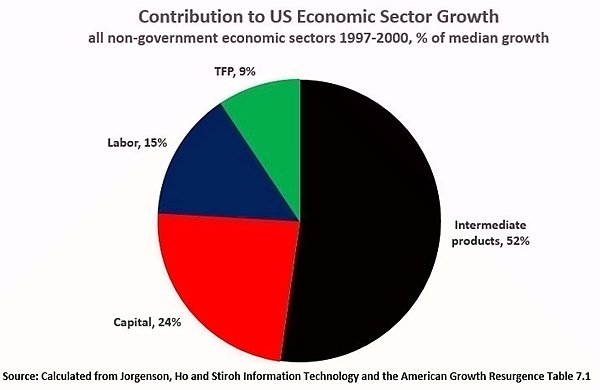Developing China's 'supply side'
- By John Ross
 0 Comment(s)
0 Comment(s) Print
Print E-mail China.org.cn, December 31, 2015
E-mail China.org.cn, December 31, 2015
TFP, increases in production due to technology, entrepreneurship, etc., account for 9% of U.S. economic growth.

Turning to a comparison with China the most detailed study by Ren & Sun found that in China as in the United States: "Intermediate input growth is the primary source of output growth." Developing China's ability to use division of labour, that is growth in intermediate products, is therefore crucial as this is the most powerful factor on the economy's supply side. But China's ability to use domestic division of labour is greatly hampered by shortage of infrastructure compared to the United States -- efficient division of labour requires ability to transport parts, efficiently communicate and coordinate production, identify markets etc.
China's number of per capita Internet users is equal to only 56% of the United States' per capita total. China's lag in "heavy" infrastructure is devastating -- China's per capita electricity consumption is only 27% of U.S. levels, with the country's length of roads 16%, and length of railways at 7%. China cannot benefit from division of labour at U.S. levels with such underdeveloped infrastructure.
Under globalisation, division of labour is international as well as domestic. From the launching of economic reform in 1978 until 2006 the percentage of trade in China's economy rose from 9.7% to 64.8% -- China made greater use of international division of labour. By 2014 this had fallen to 41.5% -- China's economy was making less use of international division of labour. Boosting China's trade is a vital supply side reform.
Turning to the second most powerful factor of economic growth, China's per capita fixed investment is only $3,199 compared to the United State's $10,017 -- China's per capita fixed investment must be tripled to reach U.S. supply side levels.
Regarding labour inputs, due to its one child policy, China's increase in working age population is negligible, and will decline in future, whereas the United State's annual increase is 0.3%. China's long run situation may alter via its new "two-child policy," and more immediately China can partially ameliorate the problem by raising its very low pension age, but the increase in China's total working time will be negligible or negative.
Measuring labour quality, OECD studies show China has a high standard up to secondary school but the United State has an overwhelming advantage in tertiary education -- the U.S. ratio of enrolment in tertiary education, compared to the number in the age group in the five years following secondary education, is three times higher than China's.
In 2009-2014 annual average TFP growth in both the United State and China was high by international standards at 0.6% in the United State and 0.8% in China -- compared to an average decline for all economies of 0.1%. However, as already noted, TFP is too small a proportion of the economy's supply side to generate fast growth.
Analysing numerically the most powerful factors on the supply side therefore yields clear results. To develop towards advanced economy status China primarily requires massive infrastructure investment facilitating development of division of labour, increases in international trade, enormous increases in per capita fixed investment, and huge expansion of tertiary education.
The writer is a columnist with China.org.cn. For more information please visit:
http://www.china.org.cn/opinion/johnross.htm
Opinion articles reflect the views of their authors, not necessarily those of China.org.cn.






Go to Forum >>0 Comment(s)